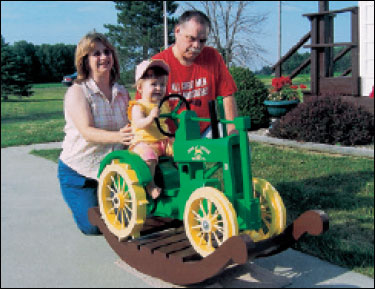Enclosed is my subscription renewal for two years.
Also, I wanted to show off my niece, who turned
one-year old in July. If you didn’t notice, she is sitting
on her birthday present from her favorite Aunt
and Uncle (that would be us, Judy and Doug). She’s
with her mom and dad; they’re both into two-cylinders
themselves. Hope she doesn’t have to share
hers with them.

Instead of a rocking horse, I made a rocking tractor.
It started out as plans for a generic tractor, but I
made some changes on it. There was no doubt it
would be green and yellow. Making the wheels was
the hardest part of the whole project. (She loves it.)
Great magazine. Doug Gedderke, Ohio

It’s nothing short of amazing, but a No. 100 One-Row
Beet Harvester has survived the past half century. The
story about it was written in two parts, which are presented
below. Initially we hear from Larry A. Gerken, whose
father kept the machine. His comments are followed by
those of Loren C. Maassel who, along with his brothers,
got it back into working order.
When farmers gather in northwest Ohio, eventually
stories will turn to the glory days of sugar beet
farming. Long hours, a lot of trucking, tons of dedication,
little sleep, and how a No. 100 Beet Harvester
changed the face of sugar beet farming forever.
Here is the story of our No. 100…
In the spring of 1960, the first John Deere Tractor
rolled onto the Gerken farm. It was a beautiful green |
and yellow “730” Diesel that my father, Lawrence W.
Gerken, purchased as part of a package deal from the
Harry VonDeylen Company, which is now owned by
Leichty’s. The deal included the “730” and No. 100
Beet Harvester, serial #C12077, to pull behind it.
The purchase price was $7500. Later, Deere refunded
$500 on the beet harvester because they were
discontinuing them. Harry VonDeylen passed that
savings on to my dad. That sign of integrity solidified
a very good relationship, and all green tractors
would follow on the Gerken farm.
The No. 100 was a welcome sight. When my family
first raised beets they had to be lifted, topped by
hand, loaded with beet forks onto wagons, hauled to
the rail spur, and then loaded onto the railcars by
hand using the beet forks. (A beet fork is a pitch
fork the size of a scoop shovel.) Later on, the beets
would be lifted, put into windrows, topped by hand,
and then loaded with a beet loader onto trucks.
So, when the No. 100 arrived and it could top, lift,
and load all in one operation, it was truly something.
Up until that time, most farmers would plant
and dig their own beets, generally eight to twelve
acres per farmer. In the late fifties there were very
few sugar beet farmers left. The sugar price was low
after World War II, and the amount of work it took
to raise the beets severely limited production. The
new technology the No. 100 brought would not only
allow a farmer to dig his own beets, but possibly
help neighbors to harvest theirs. In 1960, Lawrence
planted 100 plus acres with his John Deere 186 Tool
Bar with planter units hooked to it. Those hundred
acres would eventually grow to 300. Ironically, in
1960, when my father took delivery of the No. 100,
there were two other harvesters that were unloaded
in Malinta, Ohio, off that same rail cart. One, of
course, was ours; one went to a couple of farmers to
the south; and the third was sold to my wife’s
grandfather, Raymond Behnfeldt. The Behnfeldt’s
also harvested beets for themselves and did an
abundance of custom work.
My father harvested for over ten different farmers.
As a small child, my memories were that of very
hard-working man. When the beets were good and
the weather was wet, my father would start early,
work into the middle of the night, and then he
Click arrow for more Commentary |
 |
|





